A framework for modeling and modular verification of component - Based system designs
This paper introduces a framework for modeling and verifying safety properties of component-based systems
(CBS) by extracting their models from designs in the form of UML 2.0 sequence diagrams. Given UML 2.0
sequence diagrams of a CBS, the framework extracts regular expressions exactly describing behaviors of the
system. From these expressions, the proposed framework then generates accurate operation models represented
by labeled transition systems (LTSs). After that, these models are used to modular check whether given designs
satisfy required safety properties by using the assume-guarantee reasoning paradigm. This framework is not only
useful for modeling and verifying designs at design phase, but also for effectively rechecking the correctness of
CBS in the context of software evolution. Implemented tools and experimental results are also presented in order
to show the feasibilities and effectiveness of the proposed framework.
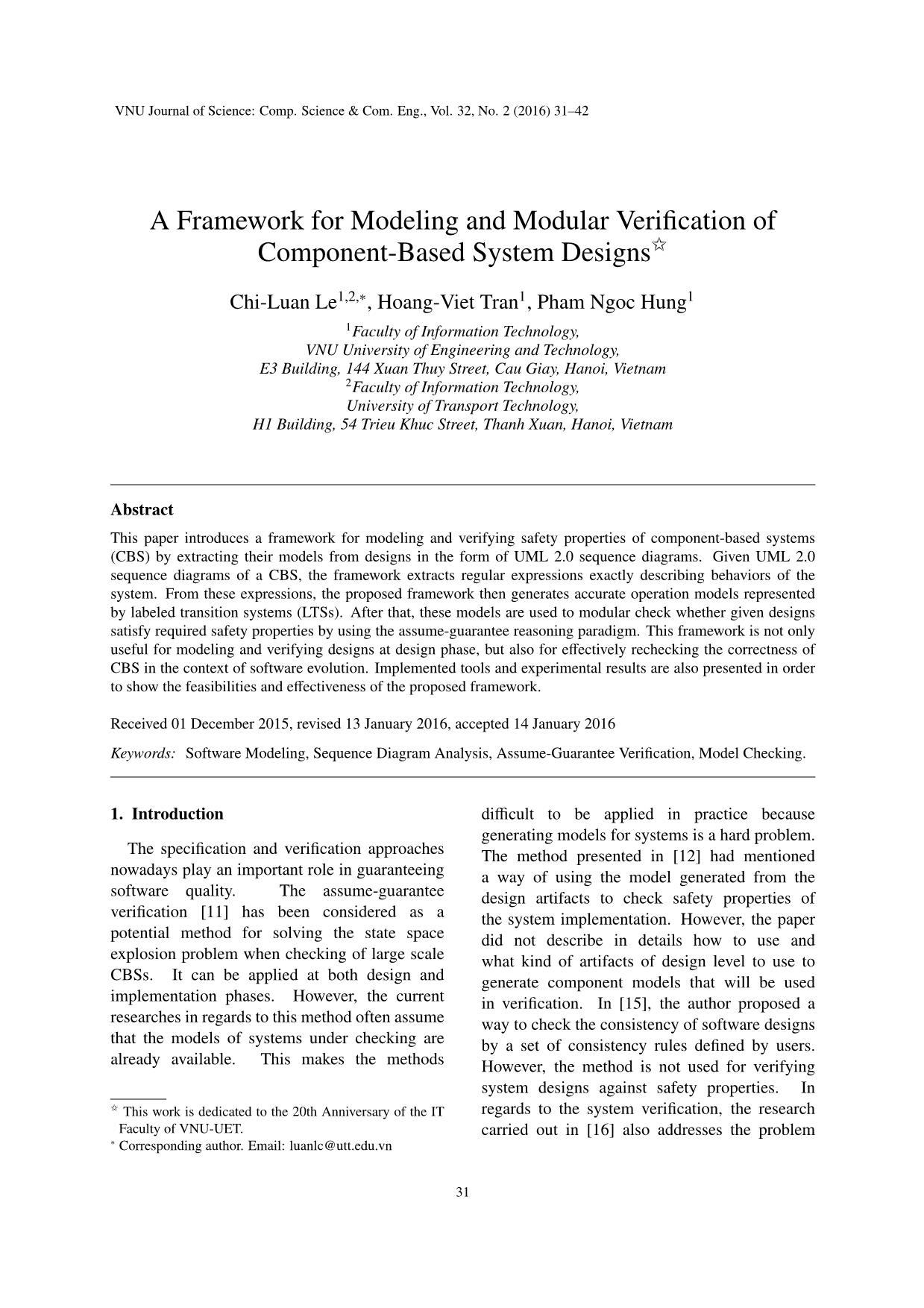
Trang 1
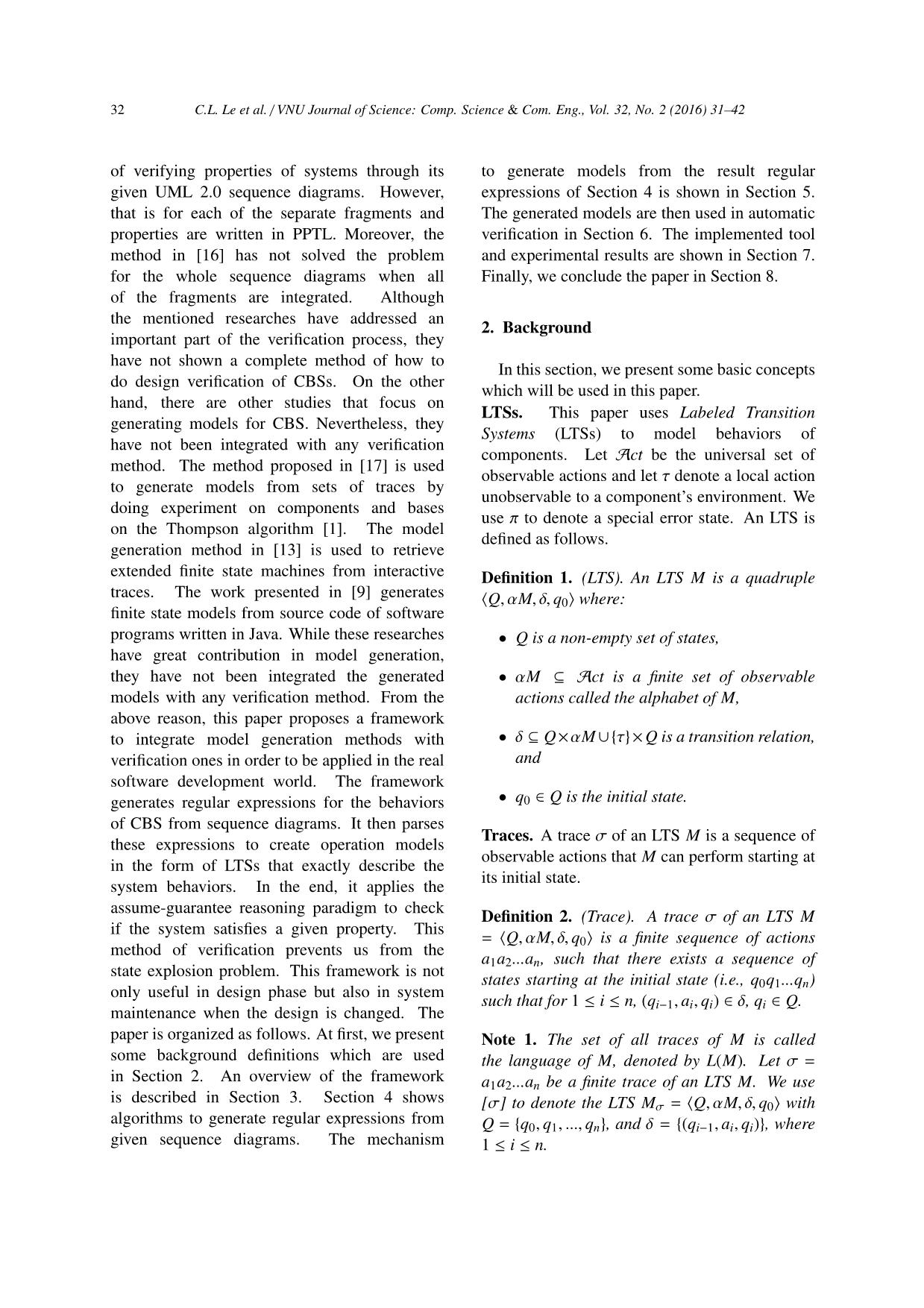
Trang 2
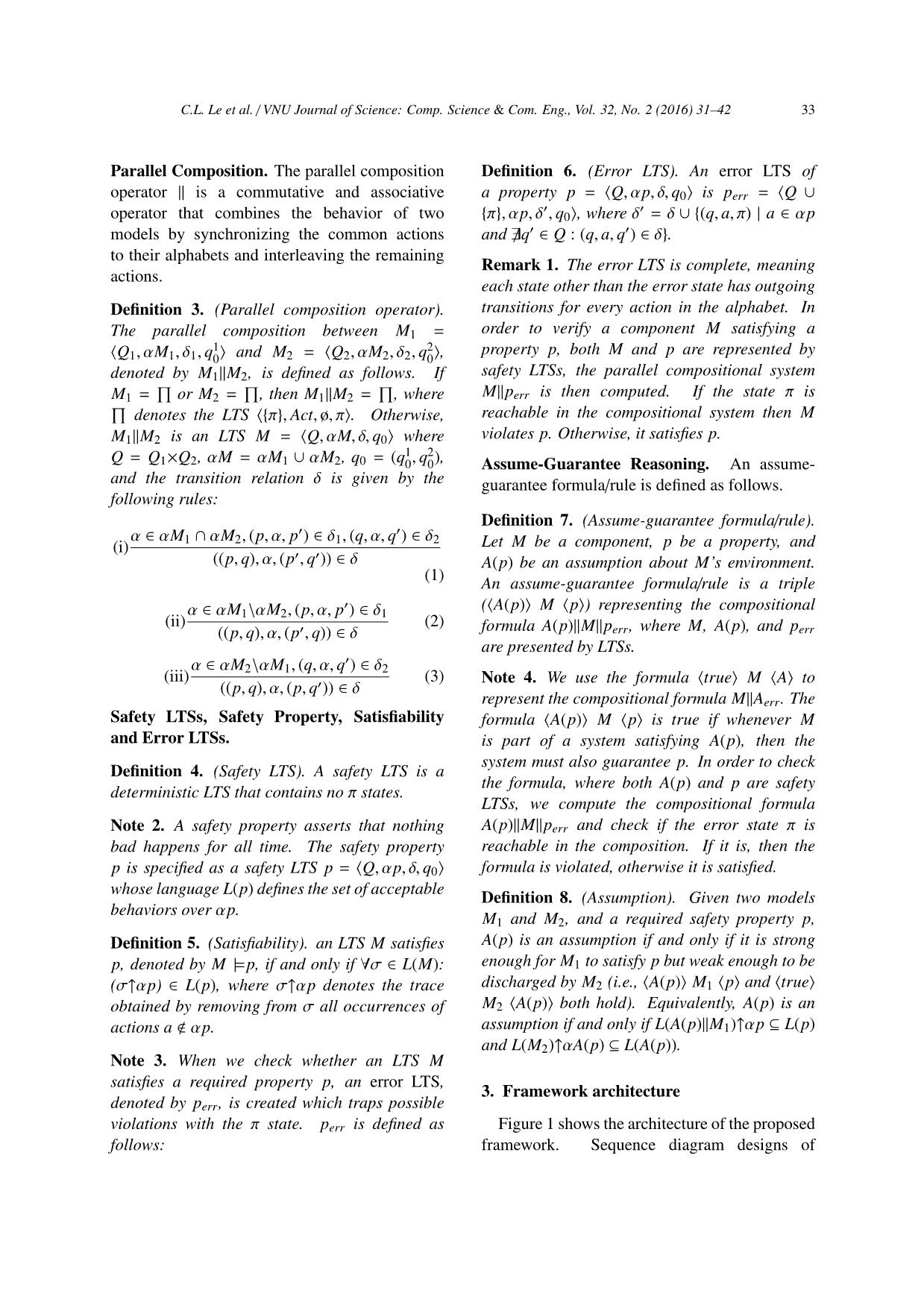
Trang 3
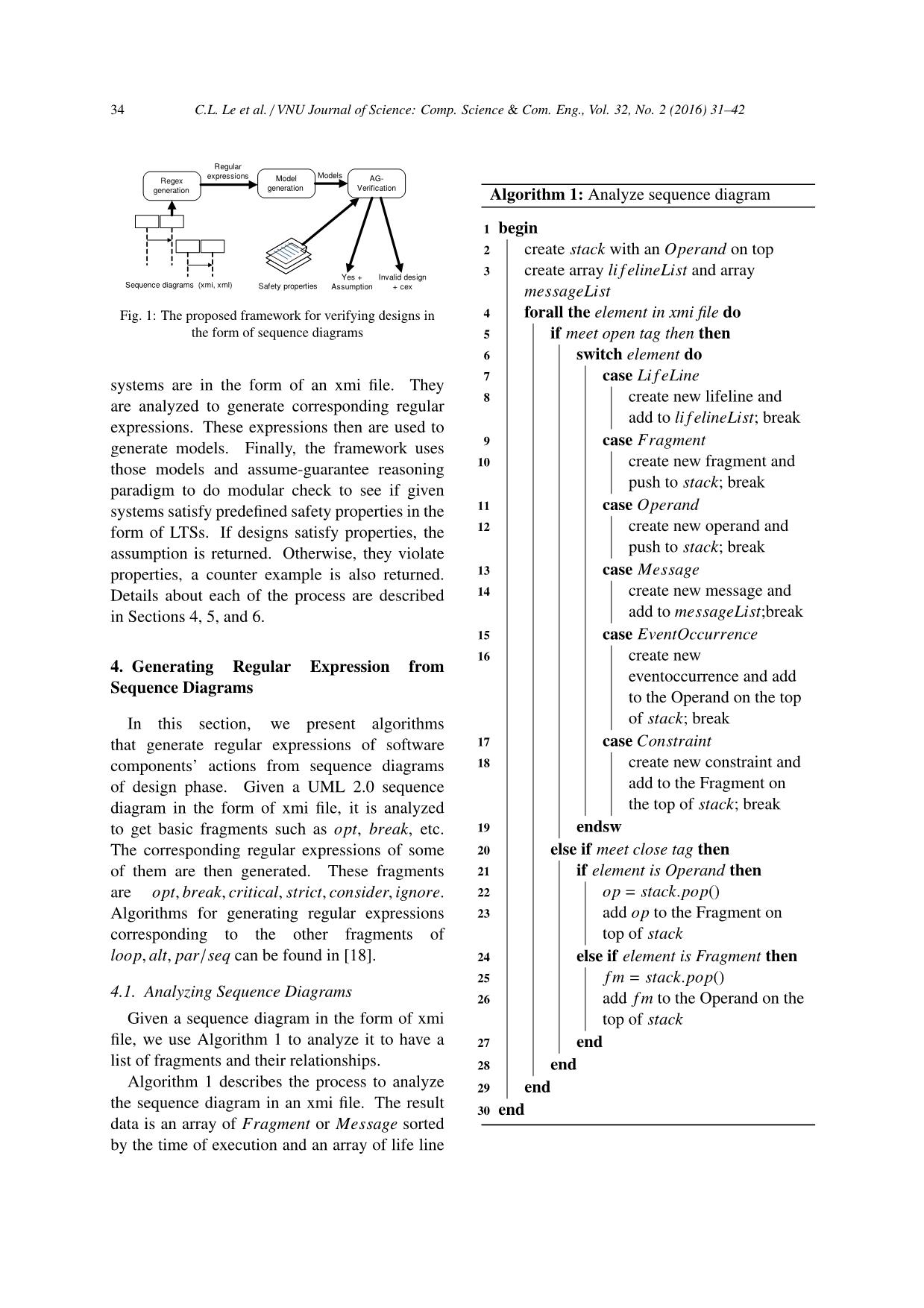
Trang 4
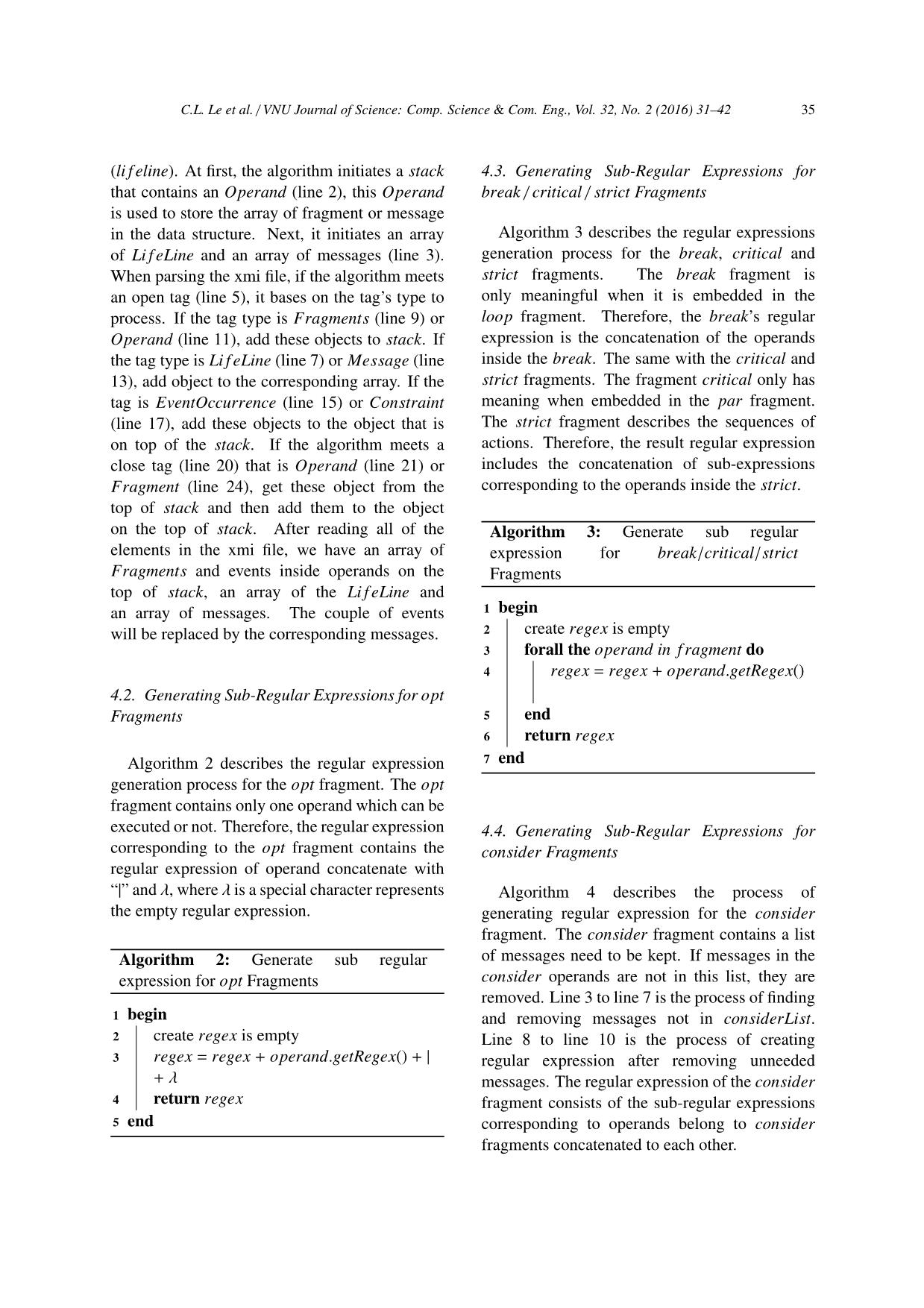
Trang 5
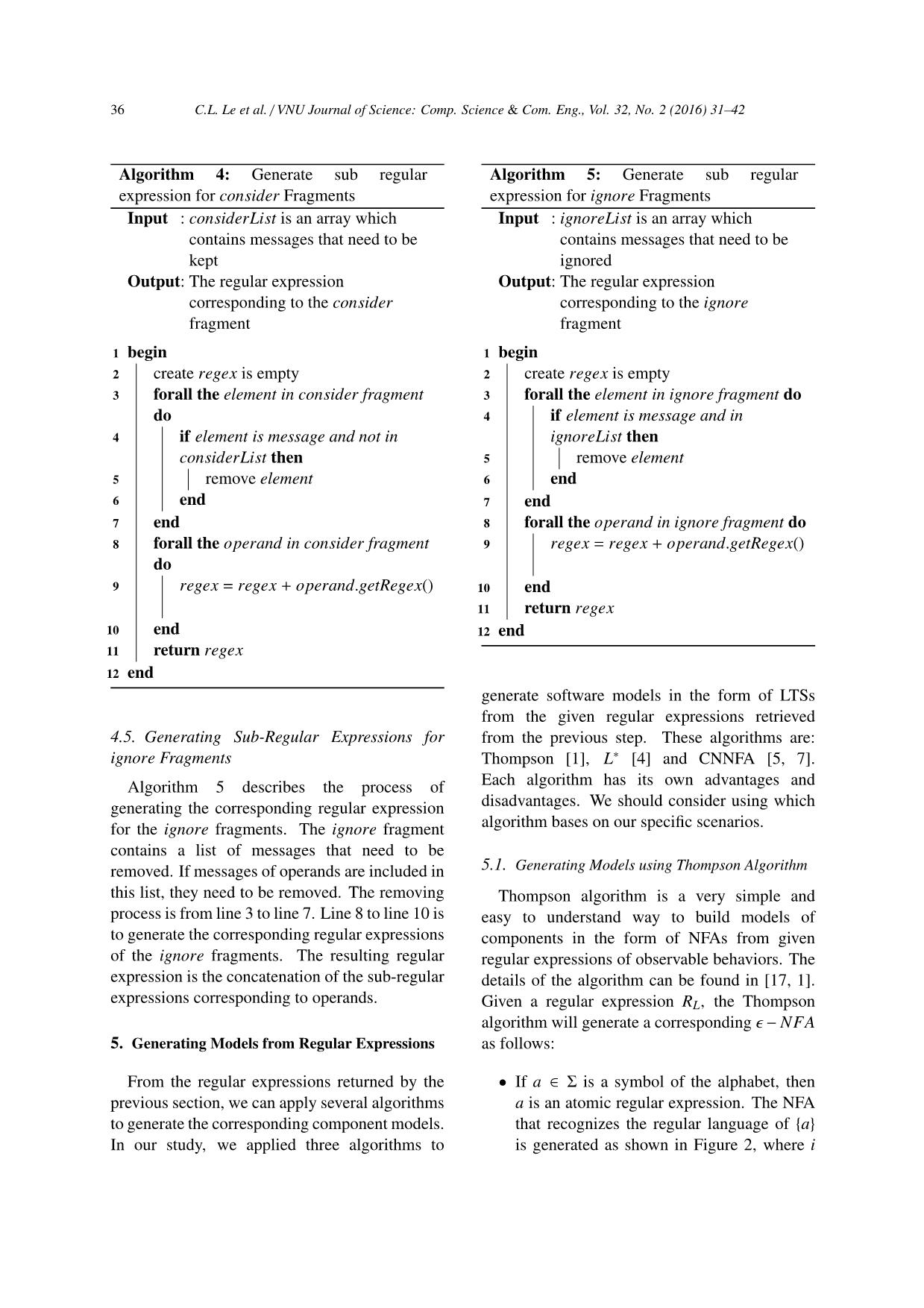
Trang 6
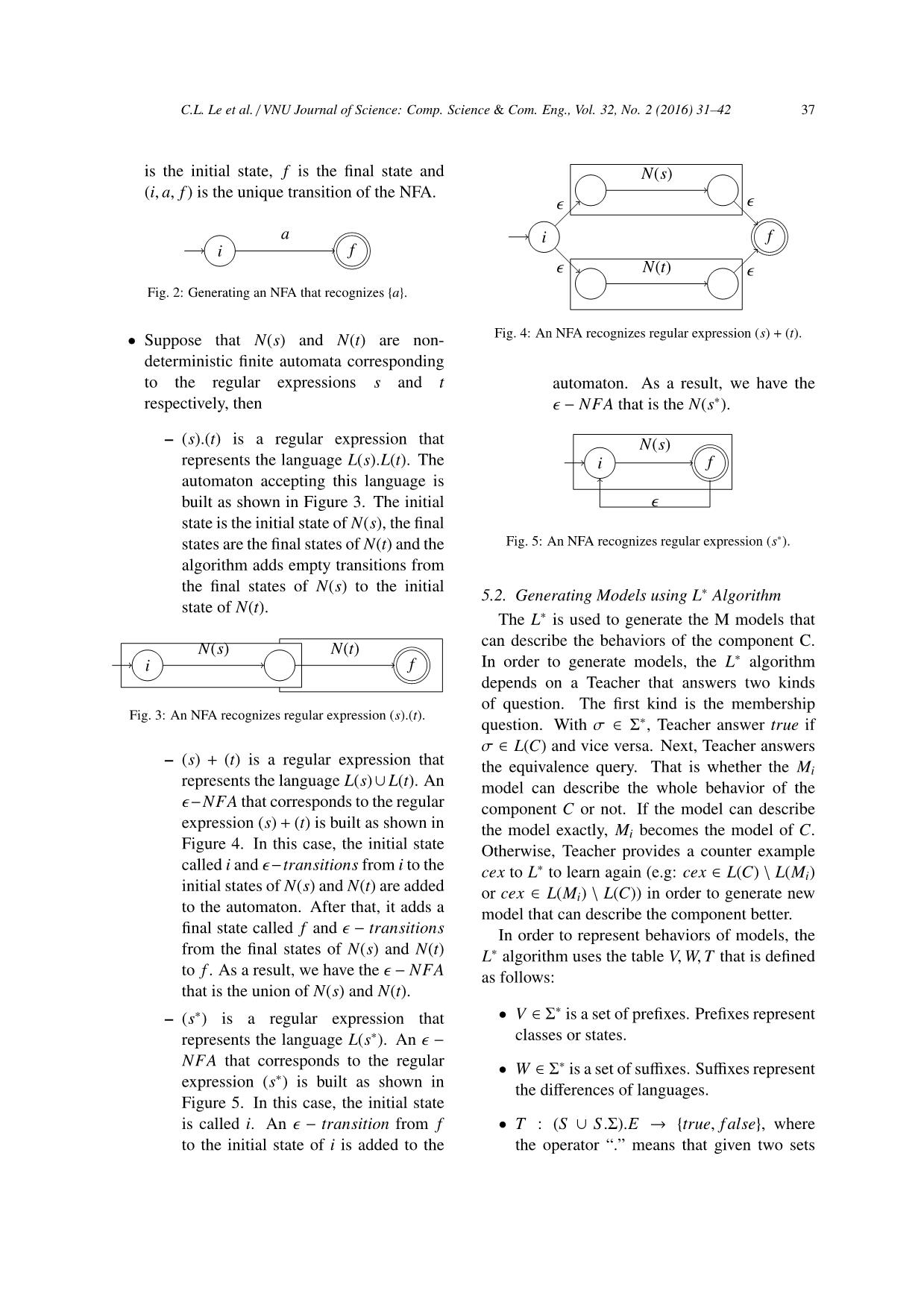
Trang 7
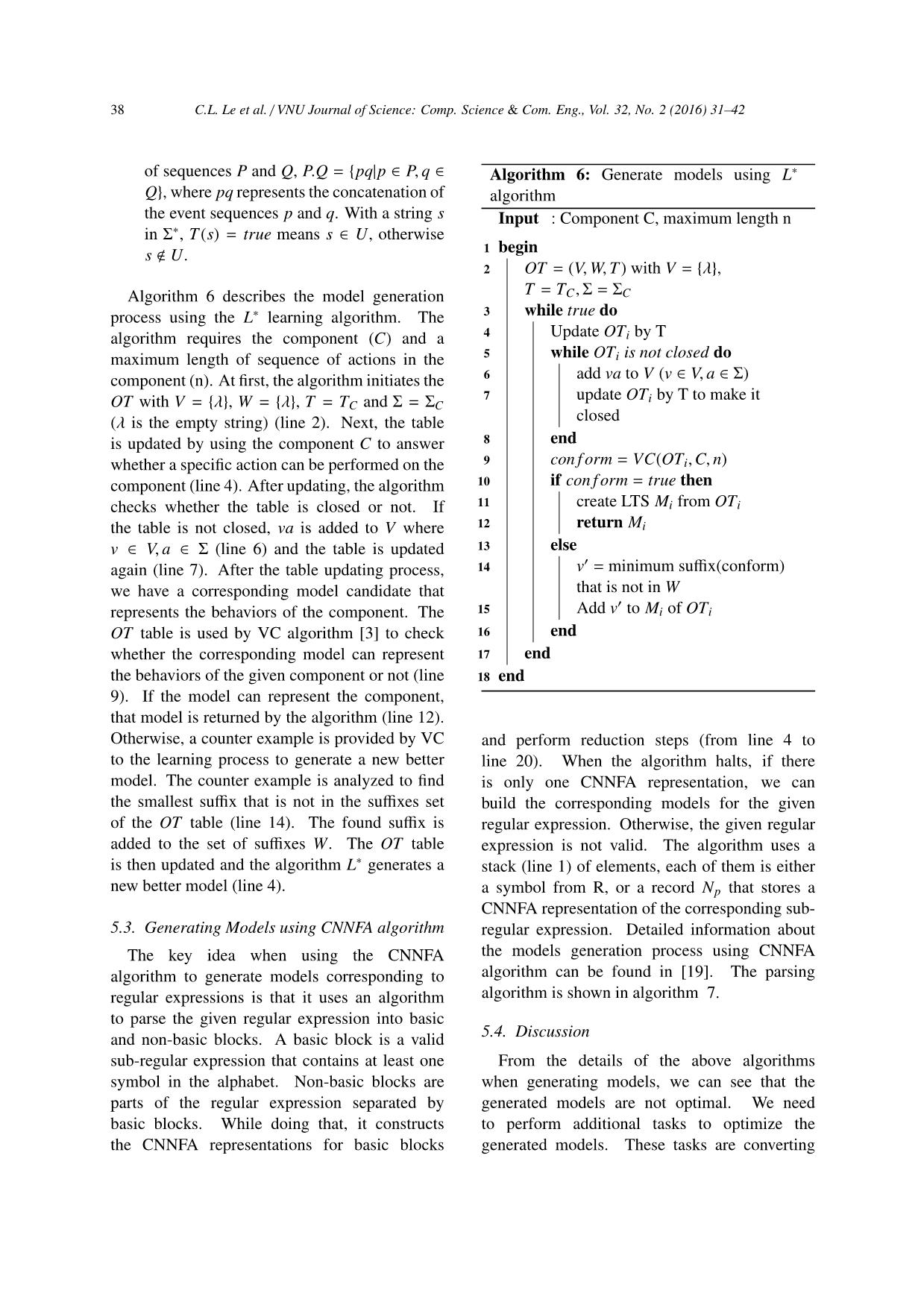
Trang 8
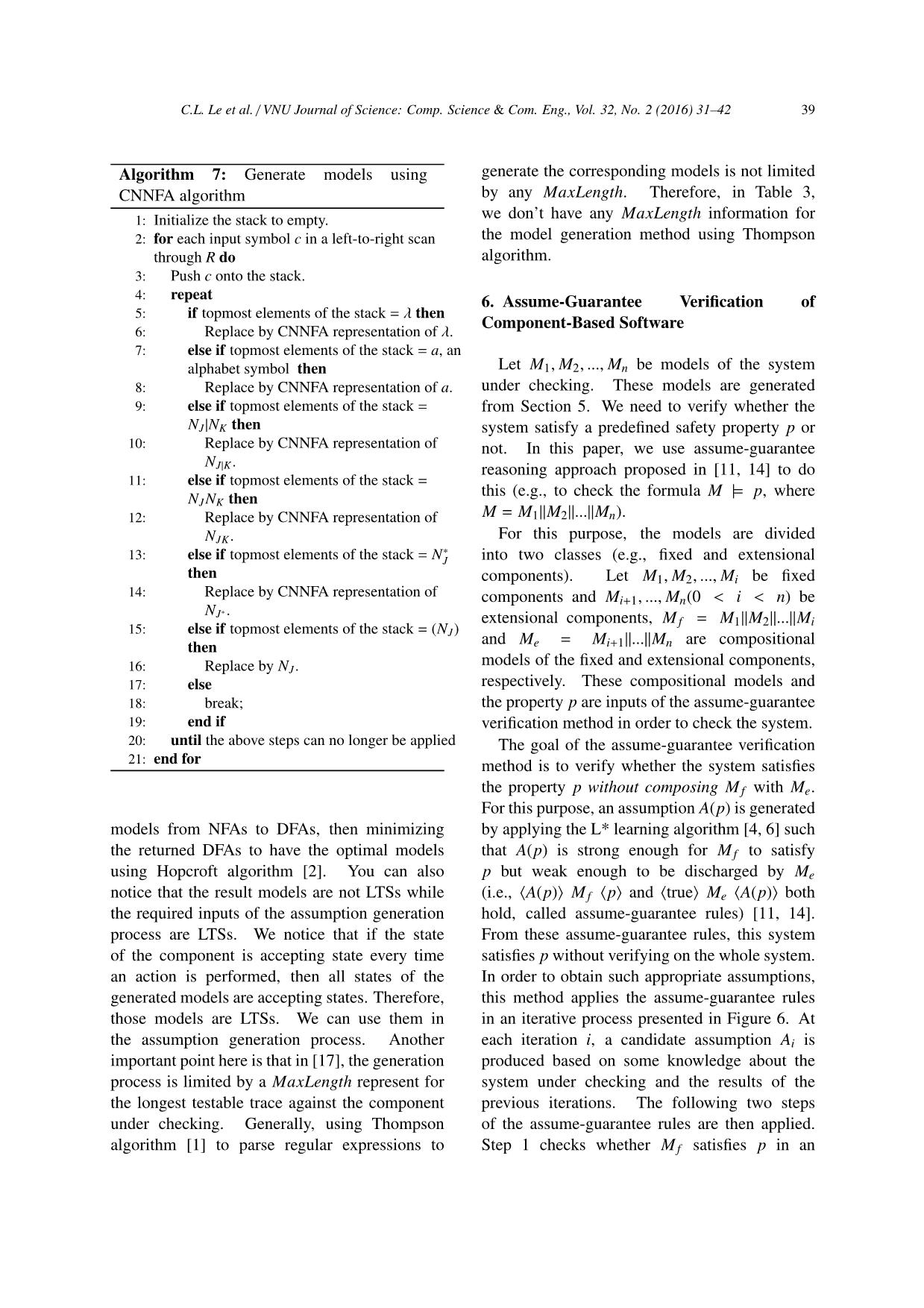
Trang 9
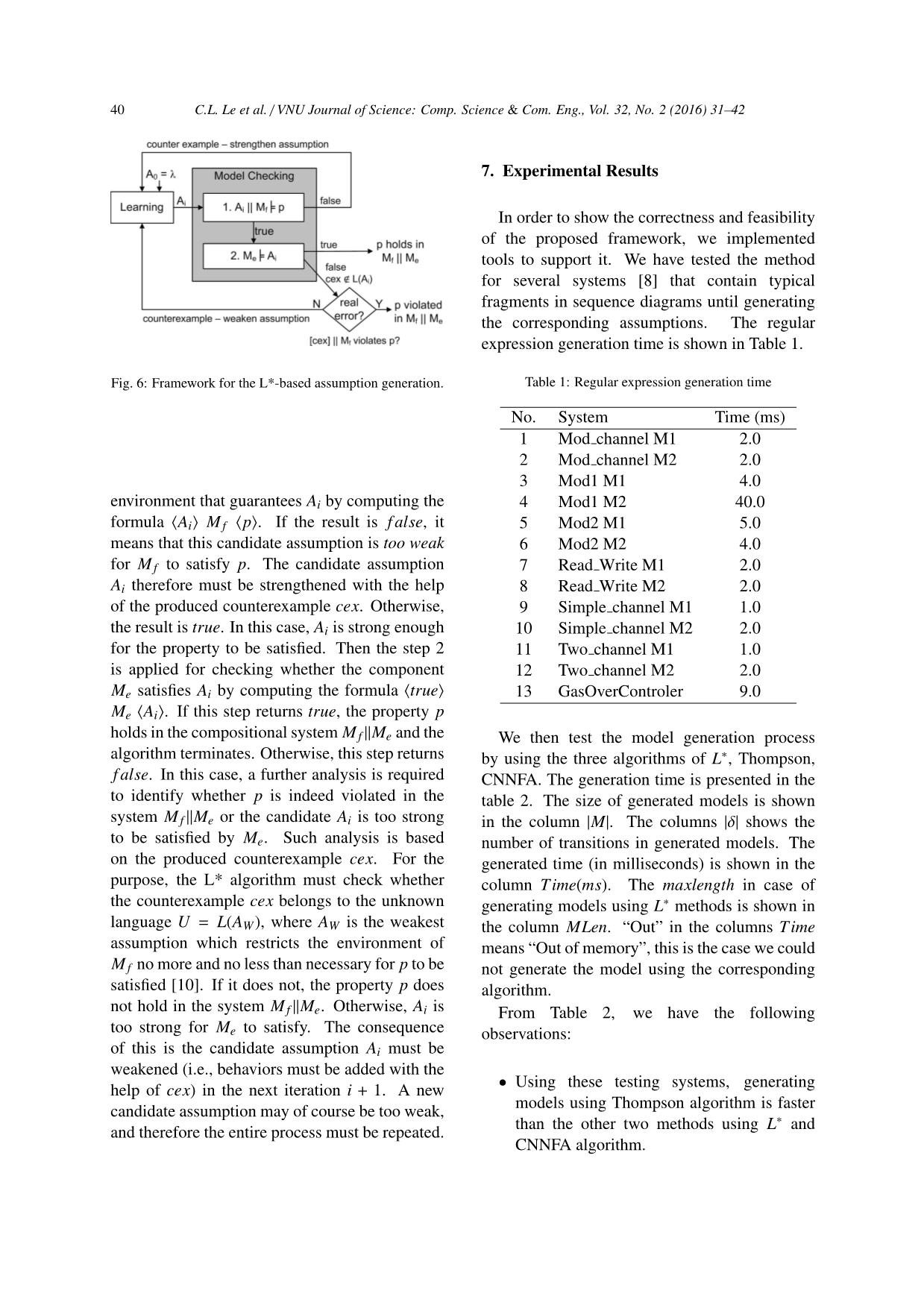
Trang 10
Tải về để xem bản đầy đủ
Tóm tắt nội dung tài liệu: A framework for modeling and modular verification of component - Based system designs
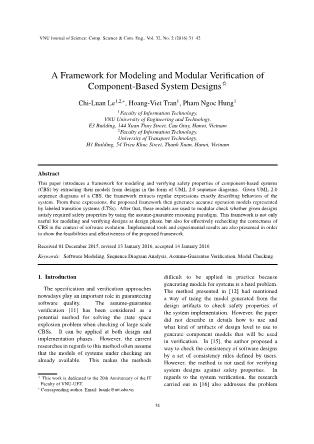
y T to make it closed 8 end 9 con f orm = VC(OTi,C, n) 10 if con f orm = true then 11 create LTS Mi from OTi 12 return Mi 13 else 14 v′ = minimum suffix(conform) that is not in W 15 Add v′ to Mi of OTi 16 end 17 end 18 end and perform reduction steps (from line 4 to line 20). When the algorithm halts, if there is only one CNNFA representation, we can build the corresponding models for the given regular expression. Otherwise, the given regular expression is not valid. The algorithm uses a stack (line 1) of elements, each of them is either a symbol from R, or a record Np that stores a CNNFA representation of the corresponding sub- regular expression. Detailed information about the models generation process using CNNFA algorithm can be found in [19]. The parsing algorithm is shown in algorithm 7. 5.4. Discussion From the details of the above algorithms when generating models, we can see that the generated models are not optimal. We need to perform additional tasks to optimize the generated models. These tasks are converting C.L. Le et al. / VNU Journal of Science: Comp. Science & Com. Eng., Vol. 32, No. 2 (2016) 31–42 39 Algorithm 7: Generate models using CNNFA algorithm 1: Initialize the stack to empty. 2: for each input symbol c in a left-to-right scan through R do 3: Push c onto the stack. 4: repeat 5: if topmost elements of the stack = λ then 6: Replace by CNNFA representation of λ. 7: else if topmost elements of the stack = a, an alphabet symbol then 8: Replace by CNNFA representation of a. 9: else if topmost elements of the stack = NJ |NK then 10: Replace by CNNFA representation of NJ|K . 11: else if topmost elements of the stack = NJNK then 12: Replace by CNNFA representation of NJK . 13: else if topmost elements of the stack = N∗ J then 14: Replace by CNNFA representation of NJ∗ . 15: else if topmost elements of the stack = (NJ) then 16: Replace by NJ . 17: else 18: break; 19: end if 20: until the above steps can no longer be applied 21: end for models from NFAs to DFAs, then minimizing the returned DFAs to have the optimal models using Hopcroft algorithm [2]. You can also notice that the result models are not LTSs while the required inputs of the assumption generation process are LTSs. We notice that if the state of the component is accepting state every time an action is performed, then all states of the generated models are accepting states. Therefore, those models are LTSs. We can use them in the assumption generation process. Another important point here is that in [17], the generation process is limited by a MaxLength represent for the longest testable trace against the component under checking. Generally, using Thompson algorithm [1] to parse regular expressions to generate the corresponding models is not limited by any MaxLength. Therefore, in Table 3, we don’t have any MaxLength information for the model generation method using Thompson algorithm. 6. Assume-Guarantee Verification of Component-Based Software Let M1,M2, ...,Mn be models of the system under checking. These models are generated from Section 5. We need to verify whether the system satisfy a predefined safety property p or not. In this paper, we use assume-guarantee reasoning approach proposed in [11, 14] to do this (e.g., to check the formula M |= p, where M = M1‖M2‖...‖Mn). For this purpose, the models are divided into two classes (e.g., fixed and extensional components). Let M1,M2, ...,Mi be fixed components and Mi+1, ...,Mn(0 < i < n) be extensional components, M f = M1‖M2‖...‖Mi and Me = Mi+1‖...‖Mn are compositional models of the fixed and extensional components, respectively. These compositional models and the property p are inputs of the assume-guarantee verification method in order to check the system. The goal of the assume-guarantee verification method is to verify whether the system satisfies the property p without composing M f with Me. For this purpose, an assumption A(p) is generated by applying the L* learning algorithm [4, 6] such that A(p) is strong enough for M f to satisfy p but weak enough to be discharged by Me (i.e., 〈A(p)〉 M f 〈p〉 and 〈true〉 Me 〈A(p)〉 both hold, called assume-guarantee rules) [11, 14]. From these assume-guarantee rules, this system satisfies p without verifying on the whole system. In order to obtain such appropriate assumptions, this method applies the assume-guarantee rules in an iterative process presented in Figure 6. At each iteration i, a candidate assumption Ai is produced based on some knowledge about the system under checking and the results of the previous iterations. The following two steps of the assume-guarantee rules are then applied. Step 1 checks whether M f satisfies p in an 40 C.L. Le et al. / VNU Journal of Science: Comp. Science & Com. Eng., Vol. 32, No. 2 (2016) 31–42 Fig. 6: Framework for the L*-based assumption generation. environment that guarantees Ai by computing the formula 〈Ai〉 M f 〈p〉. If the result is f alse, it means that this candidate assumption is too weak for M f to satisfy p. The candidate assumption Ai therefore must be strengthened with the help of the produced counterexample cex. Otherwise, the result is true. In this case, Ai is strong enough for the property to be satisfied. Then the step 2 is applied for checking whether the component Me satisfies Ai by computing the formula 〈true〉 Me 〈Ai〉. If this step returns true, the property p holds in the compositional system M f ‖Me and the algorithm terminates. Otherwise, this step returns f alse. In this case, a further analysis is required to identify whether p is indeed violated in the system M f ‖Me or the candidate Ai is too strong to be satisfied by Me. Such analysis is based on the produced counterexample cex. For the purpose, the L* algorithm must check whether the counterexample cex belongs to the unknown language U = L(AW), where AW is the weakest assumption which restricts the environment of M f no more and no less than necessary for p to be satisfied [10]. If it does not, the property p does not hold in the system M f ‖Me. Otherwise, Ai is too strong for Me to satisfy. The consequence of this is the candidate assumption Ai must be weakened (i.e., behaviors must be added with the help of cex) in the next iteration i + 1. A new candidate assumption may of course be too weak, and therefore the entire process must be repeated. 7. Experimental Results In order to show the correctness and feasibility of the proposed framework, we implemented tools to support it. We have tested the method for several systems [8] that contain typical fragments in sequence diagrams until generating the corresponding assumptions. The regular expression generation time is shown in Table 1. Table 1: Regular expression generation time No. System Time (ms) 1 Mod channel M1 2.0 2 Mod channel M2 2.0 3 Mod1 M1 4.0 4 Mod1 M2 40.0 5 Mod2 M1 5.0 6 Mod2 M2 4.0 7 Read Write M1 2.0 8 Read Write M2 2.0 9 Simple channel M1 1.0 10 Simple channel M2 2.0 11 Two channel M1 1.0 12 Two channel M2 2.0 13 GasOverControler 9.0 We then test the model generation process by using the three algorithms of L∗, Thompson, CNNFA. The generation time is presented in the table 2. The size of generated models is shown in the column |M|. The columns |δ| shows the number of transitions in generated models. The generated time (in milliseconds) is shown in the column Time(ms). The maxlength in case of generating models using L∗ methods is shown in the column MLen. “Out” in the columns Time means “Out of memory”, this is the case we could not generate the model using the corresponding algorithm. From Table 2, we have the following observations: • Using these testing systems, generating models using Thompson algorithm is faster than the other two methods using L∗ and CNNFA algorithm. C.L. Le et al. / VNU Journal of Science: Comp. Science & Com. Eng., Vol. 32, No. 2 (2016) 31–42 41 Table 2: Model generation time No. Test data L∗ Thompson CNNFA |M| |δ| MLen Time |M| |δ| Time |M| |δ| Time 1 Mod channel M1 4 3 3 01.44 3 3 00.17 3 3 00.39 2 Mod channel M2 5 5 4 20.29 3 4 00.26 3 4 11.68 3 Mod1 M1 6 6 3 16.09 5 6 00.75 5 6 26.61 4 Mod1 M2 7 8 4 53.00 5 7 00.83 5 7 233.51 5 Mod2 M1 6 6 3 15.81 5 6 00.75 5 6 76.79 6 Mod2 M2 7 9 4 48.41 5 8 01.02 5 8 421.91 7 Read Write M1 4 3 3 11.63 3 3 00.24 3 3 00.59 8 Read Write M2 4 3 3 14.55 3 3 00.20 3 3 00.74 9 Simple channel M1 4 3 3 11.06 3 3 00.22 3 3 01.73 10 Simple channel M2 4 3 3 15.05 3 3 00.20 3 3 00.74 11 Two channel M1 6 6 3 16.06 5 6 00.80 5 6 25.59 12 Two channel M2 6 6 3 18.55 5 6 00.76 5 6 27.66 13 GasOverControler - - 9 Out 6 10 66.28 7 14 4,668.43 Table 3: Assumption Generation Result No. System Verification result Time (ms) 1 Read Write acquireRead.acquireWrite 05.50 2 Mod1 OK 13.58 3 Mod2 OK 05.68 4 Mod channel in.send.send.in 00.54 5 Simple channel OK 09.21 6 Two channel OK 02.26 7 GasOverControler OK 13.11 • With the big system (GasOverControler), using L∗ algorithm cannot generate the models of the system due to out of memory. • Using the L∗ algorithm to generate the model of system is limited by the maxlength of the traces recognized by the models. The time of the assumption generation process is shown in Table 3. 8. Conclusion We have presented a framework for automated design verification for component-based software. The method generates regular expressions from one of the outputs of the design phase (sequence diagrams). Models corresponding to these regular expressions are then generated. These models are used to verify whether the design satisfies the predefined property or not. The whole process can be re-executed when the design is changed. Experimental result shows that this method is feasible with the time of the verification process. Although the proposed framework can help us to automatically verify system designs in the form of sequence diagrams, it still contains several issues. The first issue is that it is still slow when testing with large systems. The second is that the models generated and used during verification is in the form of LTSs. This is only one kind of model specification. Currently, the framework is not for other kinds. Last but not least, the framework is only applied for safety properties. What about liveness and fairness ones. Besides, the framework can be extended to generate test 42 C.L. Le et al. / VNU Journal of Science: Comp. Science & Com. Eng., Vol. 32, No. 2 (2016) 31–42 paths, test cases and help testing automatically. It can be very helpful for such organizations that not have much testing resources. We are finding a way to apply the method to some practical and larger systems to prove its effectiveness. We are also extending the method using other kinds of output of design phase (e.g., class diagrams, state-chart diagrams, etc.) so that the given system can be verified in all aspects of design automatically. Acknowledgments This work is supported by the project no. QG.16.31 granted by Vietnam National University, Hanoi (VNU). References [1] K. Thompson, “Regular expression search algorithm”, Communications of the ACM 11:6 (1968) 419-422. [2] J. E. Hopcroft, “An nlogn algorithm for minimizing states in a finite automaton”, Tech. Report, Stanford University, Stanford, CA, USA, 1971. [3] T. S. Chow, “Testing software design modeled by finite-state machines”, IEEE Transactions on Soft. Engineering, vol. 4(3), pp. 178–187, 1978. [4] D. Angluin, “Learning regular sets from queries and counterexamples”, Information and Computation, vol. 75, no. 2, pp. 87-106, Nov. 1987. [5] C. Chang, “From regular expressions to DFA’s using compressed NFA’s”, Ph.D. Thesis, New York University, New York, 1992. [6] R. L. Rivest and R. E. Schapire, “Inference of finite automata using homing sequences”, Information and Computation, vol. 103, no. 2, pp. 299-347, April 1993. [7] C. Chang, R. Paige, “From regular expressions to DFA’s using compressed NFA’s”, Theoretical Computer Science 178, pp. 1-36, 1997. [8] J. Magee and J. Kramer, Concurrency: “State Models & Java Programs”, John Wiley & Sons, 1999. The MIT Press, 1999. [9] J.C. Corbett, M.B. Dwyer, J. Hatcliff, S. Laubach, C.S. Pasareanu, Robby and Hongjun Zheng, “Bandera: extracting finite-state models from Java source code”, Proceedings of the 2000 International Conference on Software Engineering, pp. 439-448d, 2000. [10] D. Giannakopoulou, C. Pasareanu, and H. Barringer, “Assumption generation for software component verification”, Proc. 17th IEEE Int. Conf. on Automated Softw. Eng., pp. 3–12, Edinburgh, UK, Sept. 2002. [11] J. M. Cobleigh, D. Giannakopoulou, C. S. Pasareanu, “Learning Assumptions for Compositional Verification”, Proc. 9th International Conference on Tools and Algorithms for the Construction and Analysis of Systems (TACAS), pp. 331–346, 2003. [12] Giannakopoulou, Dimitra and Pasareanu, Corina S. and Cobleigh, Jamieson M., “Assume- Guarantee Verification of Source Code with Design-Level Assumptions”, IEEE Computer Society, Proceedings of the 26th International Conference on Software Engineering, pp. 211- 220, 2004. [13] D. Lorenzoli, L. Mariani and M. Pezze`, “Automatic generation of software behavioral models”, ACM, Proceedings of the 30th international conference on Soft. engineering, pp. 501-510, 2008. [14] P. N. Hung, T. Aoki and T. Katayama, “Modular Conformance Testing and Assume-Guarantee Verification for Evolving Component-Based Software. IEICE Trans. on Fundamentals”, Special Issue on Theory of Concurrent Systems and Its Applications, Vol. E92-A, No.11, pp. 2772-2780, 2009. [15] Egyed, A., “Automatically Detecting and Tracking Inconsistencies in Software Design Models”, Software Engineering, IEEE Transactions on , vol.37, no.2, pp.188-204, March-April 2011. [16] Zhang Chen, Duan Zhenhua, “Specification and Verification of UML2.0 Sequence Diagrams using Event Deterministic Finite Automata”, pp.41-46, IEEE Computer SocietyWashington, DC, USA 2011. [17] L. B. Cuong and P. N. Hung, “A Method for Generating Models of Black-box Components”, 4th International Conference on Knowledge and Systems Engineering, IEEE Computer Society Press, pp. 177-222, 2012. [18] H.M. Duong, L.K. Trinh and P. N. Hung, “An Assume-Guarantee Model Checker for Component-Based Systems”, The 10th IEEE- RIVF International Conference on Computing and Communication Technologies, pp. 22–26, IEEE Computer Society Press, 2013. [19] Tran, Hoang-Viet and Le, Chi-Luan and Nguyen, Quang-Trung and Ngoc Hung, Pham, “An Efficient Method for Automated Generating Models of Component-Based Software”, Knowledge and Systems Engineering, Springer International Publishing, volumn 326, pp. 499- 511, 2015.
File đính kèm:
 a_framework_for_modeling_and_modular_verification_of_compone.pdf
a_framework_for_modeling_and_modular_verification_of_compone.pdf

